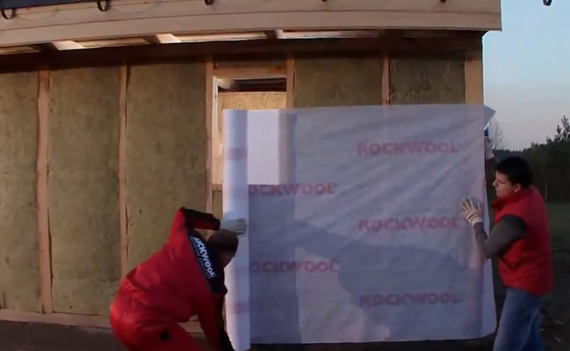Due to its affordable cost, durability and strength, timber has become a popular material in the construction of houses. Natural wood creates a healthy microclimate inside the premises and has good vapor permeability. Low thermal conductivity is one of the advantages of a timber, but insufficient wall thickness causes high heating costs.
Even with careful joining, gaps remain between the lumber, allowing cold and draft into the room. You can change the situation by insulating a log house. The process of thermal insulation of a wooden building is distinguished by the availability of technology, so it is really possible to do it yourself.
Why is it preferable to put the insulation outside?
External thermal insulation log house has its advantages:
- reduction in heating costs;
- hygroscopic protection wooden walls from exposure to moisture;
- the appearance of the facade changes according to the individual preferences of the owners;
- the area of \u200b\u200bthe internal space does not decrease.
Selection criteria for thermal insulation material
When choosing a heater, you should pay attention to its characteristics: elasticity, resistance to combustion and moisture, thermal conductivity, air permeability. The thickness of the effective layer depends on the temperature in the region and the parameters of the bar. In temperate climates, 50 mm is sufficient thermal insulation material, and with winter frosts below -20 degrees, this figure doubles. The complexity of installation should also be taken into account, because the work is done by hand.
Insulation methods, what to choose for walls from a bar
Exterior decoration of a log house is carried out in three ways:
- Ventilated facade construction.
The hinged structure includes a wooden lathing, insulation and external cladding made of lining, siding or porcelain stoneware. Do-it-yourself facade installation gives the walls additional heat and sound insulation and brings the dew point outside. The structure is easily assembled and lasts up to 50 years.
- Hermetically sealed with polyurethane foam.
Polymer spraying creates a monolithic seamless surface and strengthens the timber walls. The work is carried out using a high pressure washer. It mixes the two components and delivers the compound through a gun to the surface to be insulated. Condensation does not collect under the polymer layer, it does not burn, does not rot, and reduces the noise level. After spraying the polyurethane foam, it is required finishing facade material. The main disadvantage of this insulation method is its high price.
- Use of foam boards.
The low cost of the material makes it the most affordable insulation. It is resistant to fluctuations in temperature and humidity, but has a significant drawback - it supports combustion. Fixing the foam on the walls is done with special glue. Before the installation of the first row, a starting profile is nailed to limit material slippage.
Having analyzed the pros and cons of the ways in which you can insulate log house outside, most owners settle for a ventilated façade.

Practical insulation for a wooden house
Mineral wool will be the best choice for home insulation. It is made from slag, rocks or glass and therefore does not support combustion. The material is easy to fit with your own hands, retains heat well and is affordable.
How to properly assemble a ventilated facade
Technology correct installation curtain facade includes several stages:
- fastening the lathing;
- laying insulation;
- installation of a diffuse membrane;
- fixation of decorative coating.
Work begins with the application of an antiseptic layer to the timber, which protects against decay and moisture. A frame made of wooden planks is stuffed onto the finished surface. The step of the vertical lathing is 1.5 cm less than the width of the insulation. This will allow the material to fit tightly, avoiding crevices and cold bridges.
The bars are attached to the wall with self-tapping screws, their vertical plane is set using a level with a plumb line. Mineral wool mats are inserted between the frame slats, pressed tightly and fixed with umbrella dowels. When located wooden house in a region with low temperatures, it will be correct to perform external thermal insulation in two layers.
To protect the insulation from dampness, a special perforated film is laid. It does not allow water to penetrate inside, and releases moisture accumulated in the cotton wool outside. The membrane is laid with an overlap and fixed with staples, its joints are glued with tape.

The ventilating layer of the façade is created by padding strips over the waterproofing. They provide a space between the insulation and the cladding in which air circulates. The second row of slats becomes the basis for the finishing facade coating. There are ventilation slots in the lower and upper parts of the structure. They are protected from precipitation by special visors.
Mineral wool is an excellent insulation material, but it loses its qualities when wet, so it should be stored indoors. When working with the material, dust and fibers are generated, which cause irritation. Laying mineral wool slabs must be in goggles and gloves.
It does not take much time and money to insulate a log house from the outside. The result of quality work will be a comfortable room temperature with lower heating costs.
You can insulate a wooden house yourself. Warm, protected from the effects of atmospheric precipitation, with a new planking, a house made of timber will be more comfortable for life. Heating bills will also decrease. Examine the stages of work on the arrangement of the thermal insulation layer.
In contact with
Main steps
Observe technology insulation of a wooden house outside, carry out the work carefully and in the specified sequence:
- the first layer is a film for vapor barrier walls;
- installation of frame lathing;
- direct installation of the selected insulation;
- fastening to the frame of the waterproofing layer;
- installation of facade cladding.
The choice of insulation
The better to insulate wooden house? Check out some of the popular wood protection materials.
Mineral wool
Many owners choose mineral wool. Quite justified. This lightweight material:
- keeps warm well;
- not subject to combustion;
- it is soft and elastic;
- easy to work with;
- withstands temperature changes;
- there are no cold bridges.
External wall insulation with mineral wool is often used by owners of new and old houses from a bar. First, equip the frame and fill it with rolls of mineral wool. The material fills the voids well.
The supporting structures of the frame tightly hold the mineral wool. Additional mounting is not required. The material is produced in rolls, plates or mats.
New boards are laid on top and cladding with plastic siding is carried out. The building will acquire modern look.
Ecowool
This insulation came to us from Finland. In harsh conditions, the material, consisting of cellulose and antiseptics, has successfully passed the test of severe frosts and icy winds.
Advantages:
- eco-friendly, natural material;
- prevents the appearance of mold;
- mice do not gnaw ecowool;
- excellent noise and heat insulation;
- used for external and internal insulation;
- the walls "breathe" well;
- does not emit toxic substances when smoldering.
Installation of ecowool does not require a vapor barrier. Methods of applying cellulose mixture: wet-glue, bulk, blowing method using a special machine.
A high-quality, monolithic layer 10 cm thick will allow you to create reliable protection by cold. Suitable for use in various climatic zones.
Styrofoam
 This material is used to insulate the house from the inside. Outside, insulate a house from a bar with expanded polystyrene not recommended... Cause? The material is poorly breathable. The result is the appearance of condensation, rotting wood, the development of mold fungi.
This material is used to insulate the house from the inside. Outside, insulate a house from a bar with expanded polystyrene not recommended... Cause? The material is poorly breathable. The result is the appearance of condensation, rotting wood, the development of mold fungi.
Cold bridges are inevitably formed between the base and expanded polystyrene in places of loose fit. Some of the heat will go to waste.
For internal thermal insulation, with the help of foam plastic, first, it fills the rack frame to provide an air gap. Plates up to 5 cm thick are fixed with adhesive solutions or special fasteners.
Insulation of the walls of a wooden house from the outside
Have you already decided on the type of insulation? Mineral wool or ecowool - you decide. It remains to consider stages of insulation of external walls of a wooden house.
In the photo you see one of the insulation options, the order of work.
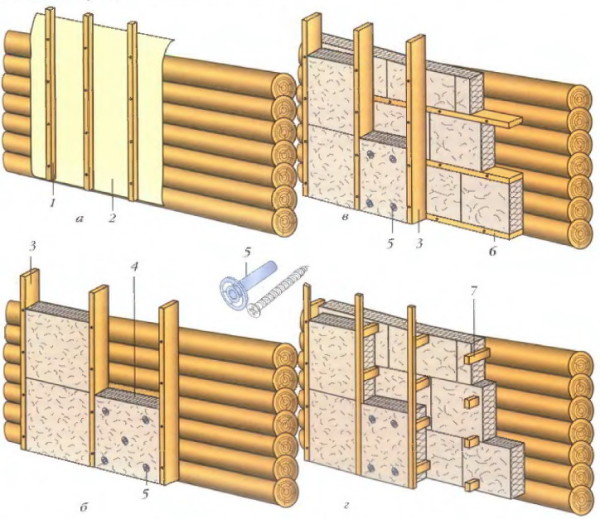
Vapor barrier
The task of this layer is ensure adequate ventilation of the facade under the foil... If the facade is made of round logs, you can fix the material directly to the tree. The clearances will be sufficient.
On a smooth surface, you first need to stuff wooden slats. Thickness - 2.5 cm. Observe the distance between them - within a meter.
You will need aluminum foil, roofing felt, a special vapor barrier film. Attach the vapor barrier to the battens. Cut a ventilation hole at the top and bottom. Diameter - 2 cm.
Important: Where nails or staples are driven in, tape the surface to seal.
Arrangement of a wooden frame
You will need a regular board. Width - no more than 10 cm, thickness - no more than 5 cm. Thinner for this design are not suitable.
Nail the boards vertically. Make sure that the distance between them is 1-2 cm less than the width of the insulation. This will prevent cracks and voids from appearing.
Thermal insulation
If you chose ecowool, use a blowing machine to apply the cellulose mixture to the wall. Remember - no vapor barrier required!
Place the mineral wool slabs in the prepared frame, achieving a snug fit. Choose a semi-rigid board with a density of 120kg / m3. Additional fastening is not required.
Waterproofing layer
You you need a special film with a vapor permeability of more than 1300g / sq.m. its task is to let steam through, but not to allow it to get on the insulation layer. Installation is carried out in the same way as when installing a vapor barrier layer.
It remains to fill boards on the frame to dry the condensate that has fallen on the waterproofing layer. Boards with a thickness of 2.3 to 3 cm and a width of 5 cm are suitable.
Install a fine mesh metal mesh underneath to protect against insects and rodents. Pay special attention to the arrangement of the protective layer when insulating a log house with mineral wool.
Outer sheathing
What will your house look like after insulation? You can stuff wooden lining or Euro lining made of larch, oak or pine. Process the boards, open them with varnish.
Consider the design of doors and windows. Insulation will increase the thickness of the walls up to 25cm. You can move them to another place and equip new ones wooden frames, platbands, window sills.
The second option is to give your home a stylish, modern look. You need a block how, vinyl or metal siding. Work is carried out from the bottom up. Fasten the cladding with screws or nails.
To your attention a video about the insulation of a wooden house outside. What is better to insulate?
Insulation prices
Insulation of private houses and cottages can be done independently. This option only costs material.
Many owners turn to construction firms. If you do not have the skills, time and desire to insulate your home, allocate a certain amount to pay for the work of professionals. Average prices are as follows.
A full range of works on the arrangement of thermal insulation: from 1080 to 4000 rubles. per sq.m. The total cost depends on the chosen insulation and the method of installing the protective layer.
Thermal insulation of a wooden house from the outside - a process that requires a balanced approach to all stages of work... Buy quality materials, heed the advice of experts, follow the technology - and your house from a bar will be warm. The new decorative façade will set the mood.
In contact with
Do you see inaccuracies, incomplete or incorrect information? Do you know how to make your article better?
Do you want to offer photos on a topic for publication?
Please help us make the site better! Leave a message and your contacts in the comments - we will contact you and together we will make the publication better!
There are often situations where walls in a wooden house lose one of their functions, such as keeping heat. In this case, they resort to insulating the walls of the house from the outside. Insulation becomes protection from cold air.
This solution to the problem also has several more advantages: the building wall gains additional protection from sunlight and dampness and will last longer.
Advantages of external thermal insulation
External home insulation has several advantages:
- The main thing among which, of course, is the preservation of heat. This type of insulation prevents a sharp drop in temperature... The wall, reinforced from the outside, maintains a high thermal protection.
- Unlike internal insulation, with external insulation there are no areas in which there is no heat, the so-called "cold bridges" since with this type of insulation it is possible to install heat-insulating material in the places where the floor joins the outer walls.
- Also, external insulation prevents the penetration of moisture into the walls of the house.
Do not forget about the shortcomings of outdoor insulation. Such a process of warming wooden houses rather complicated and time consuming.
Warming methods
There are several types of insulation:
- The insulator is mounted on the wall with an adhesive solution.
- Facade ventilation. The wall is protected by waterproofing, insulation is attached from above, a windscreen is installed, after which siding or other material is installed on the frame.
- Three-layer non-ventilated wall. The insulation is fixed with mortar, the outer wall is mounted in one brick, while observing the air gap.
Naturally, each type of material has its own subtleties in performance... It should not be ruled out that there are combined insulating materials on the market for insulation products, or materials for which it is necessary to adhere to the technology itself.
The big plus is harmlessness. Such insulation is environmentally friendly. The only drawbacks are high price.
Expanded polystyrene
Gas filled material like polyurethane foam. It is obtained from polystyrene and its derivatives. Such material is vapor-permeable, absorbs water well, biologically stable, long service life. These are definitely pluses.
Of the minuses - flammability, which makes it a rather dangerous material.
Styrofoam
The most popular material for exterior insulation of wooden houses. It has a cellular structure because cells are insulated, foam has good thermal insulation, which is definitely its plus.
Also, foam insulation gives good sound insulation, no need for additional waterproofing, ease of installation and durability.
Like all materials, foam has its drawbacks: it is unsafe because burning produces corrosive substances, has low strength.
When choosing a heat-insulating material, you should pay attention to its service life, safety. The choice of material for insulation should be approached responsibly, to study all the pros and cons. Preference should be given fireproof and environmentally friendly materials.
Do you know the best way to sheathe a wooden house outside? Read this article.
We insulate a wooden house with our own hands
Insulation technology begins with the installation of a frame on which the insulation will lie.
Bars are nailed to the wall to be treated made of wood 50x50 mm in size, keep in mind that the distance should be no more and no less than 580 mm of security. The material must be laid so that there are no gaps between the wall and the bars.
Next stage - providing vapor barrier... For this, aluminum foil, polyethylene film or vapor barrier film are used. There is no need for a vapor barrier if the house is made of round timber.
When the plane is smooth, the slats are stuffed onto which the vapor barrier layer is mounted. It should be borne in mind that between the slats from below and from above there should be a stoma of 20 cm in diameter for ventilation. The places of fastening of the material for the vapor barrier are sealed with adhesive tape in order to protect against moisture.
The vapor barrier is followed by the thermal insulation. The material must be installed so that there are no gaps and gaps between the frame boards. The material is laid in two layers of 50 mm each so that the joints of the first layer are aligned with the middle of the second.
For a secondary layer of thermal insulation bars are nailed across walls perpendicular to the main frame row.
Next is waterproofing. The waterproofing film must easy to pass steam and good water retention... A waterproofing layer is applied to the heat insulator layer. It is nailed to the frame.
Next is the stage of installing the secondary layer of the frame. The first layer (on top of the waterproofing layer) is filled with slats 50 mm wide and 30 mm thick.
The installation of the next layer of the frame is carried out for free air movement between the vapor barrier layer and the cladding, so that moisture trapped on the waterproofing layer is dried.
The space formed at the bottom is necessarily covered with a dense metal mesh from the penetration of rodents and insects.
At the last stage, the house is sheathed with the appropriate material (siding, lining, facade panels, etc.). It should be borne in mind that wall thickness will increase by 20-25 cm and, accordingly, you need to think about the protection of the insulation from the side of window openings.
Thermal insulation of a wooden house outside: video instruction.
- The choice of material for insulating a wooden house
- Calculation of the amount of materials
- Laying insulation of a wooden house
- Final wall decoration
If you insulate a wooden house, it can be used not only for summer vacations, but also for permanent residence during the whole year. Thermal insulation of the house will significantly save on heating it in the winter. You can insulate the house with your own hands.
After that, the crate is installed. Slats are mounted on top of the moisture insulation. First, you need to measure the width of the mineral wool slab, since they are produced in various sizes.
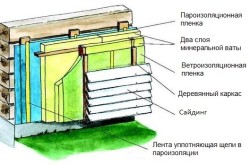
Subtract 2 cm from this value. The resulting distance must be maintained between the vertical slats on the entire surface of the wall. The first rail is fixed with self-tapping screws to the corner of the building. Then, when the other side of the house is insulated, the outer rail will be attached to this rail.
The rest of the slats are installed at the same distance from each other. This distance was determined at the beginning. When installing the rails, it is necessary to observe their verticality, which must be systematically controlled using a building level. After that, proceed to the installation of mineral wool. Cut pieces of cotton wool of the required size with a sharp knife. Plates are laid close to each other. For this purpose, a distance was specially left between the slats, reduced by 2 cm. This ensures dense laying of the material without gaps.
The insulation is mounted using metal anchors. To do this, holes must be drilled in the slab between the bars at a distance of 50 cm from each other, through the slabs, into the wall surface. Then anchors are driven into these holes. Then, cores with a special head are installed in the anchors. In this case, the anchor is fixed, and the insulation is firmly laid.
Then the waterproofing insulation is laid. After all the thermal insulation has been laid, it is necessary to install another layer of waterproofing film. In this case, the film is installed with the rough side to the mineral wool slabs. This will ensure the removal of moisture from the insulation and the impossibility of moisture passage in the opposite direction. Waterproofing is installed with a stapler by attaching staples to the bars.
With internal insulation, not only the useful area of \u200b\u200bthe premises decreases, but also the dew point shifts inside the frame. Only the inner space is insulated, the log house itself constantly experiences changes in humidity and temperature, freezes in winter and rots in summer. The greatest destruction of the log house in this case occurs from the inside, closed with insulation.
External insulation protects from freezing not only the room, but also the frame itself. The dew point is shifted to the outside, and condensation occurs outside wooden structures, under a ventilated façade where moisture dries quickly.
Materials for insulating a wooden house
Mats made of stone or mineral wool are most in demand as insulation for wooden houses. It is not recommended to use polystyrene for insulating wooden structures, since it does not have vapor permeability and does not remove moisture vapor from the surface of the log house. Stone wool or mineral wool mats come in a variety of thicknesses and densities. The denser the insulation, the easier it is to install and the longer it retains its performance characteristics. Soft and loose mats often slide down, disintegrate, forming dust harmful to health. Therefore, you should not save on high-quality insulation. Other advantages of stone or mineral wool include its incombustibility and unpopularity with rodents, in contrast to foam.
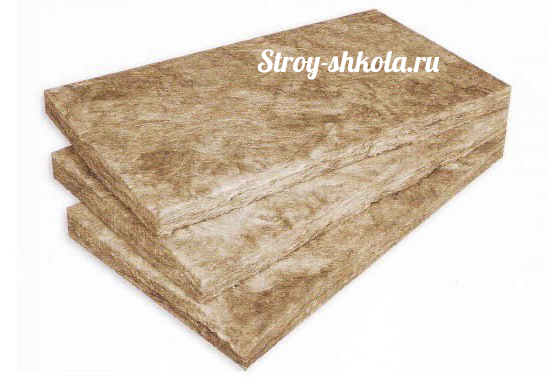
In addition to insulation, two layers of film are needed: one is waterproof and protects the frame from moisture penetration. It is placed on a protected wooden surface. This film must be vapor-permeable and remove moisture from the log house through the insulation to the outside environment. The second is wind and water protection, it is attached over the thermal insulation. The purpose of this layer is to protect the insulation from moisture entering from the external environment. Waterproofing of mineral insulation is required, since when wetted, it loses its thermal insulation properties.
From the outside, the insulation is closed with any facing material with the obligatory arrangement of a ventilation gap. This cladding is called a ventilated facade. Thanks to the air circulation between the cladding and the walls, the formation of fungus and mold is excluded, moisture is successfully removed from the insulation and all conditions are created for the long service of the log house and the entire building.
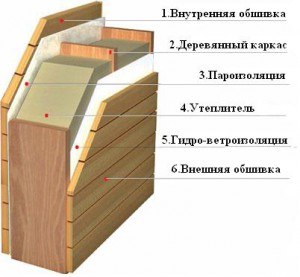
Thermal insulation technology of a wooden house outside
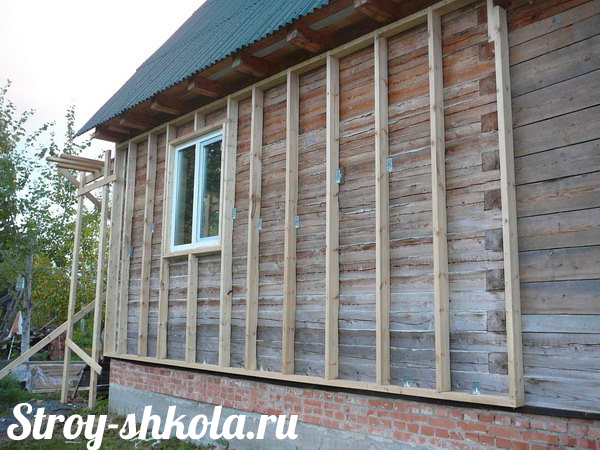
An additional measure to protect a wooden house is insulation of the foundation and basement. It can be produced using or, as well as by spraying polyurethane foam. A ventilated facade or cladding is also mounted on top of the insulation layer decorative stone or brick.




